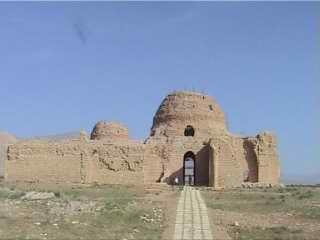Sarvestan on:
[Wikipedia]
[Google]
[Amazon]
Sarvestan ( fa, سروستان ''Sarvestân'', "land of cedars"; ''sarv'' "cedar" (cypress) + '' estan''; also
 Sarvestan's history goes back some 2600 years when the
Sarvestan's history goes back some 2600 years when the
File:Fimt0120112156.jpg
File:Rebatsarvestan09.jpg
Islamic Azad University of Sarvestan
Payame Noor University of Sarvestan
Romanize
Romanization or romanisation, in linguistics, is the conversion of text from a different writing system to the Roman (Latin) script, or a system for doing so. Methods of romanization include transliteration, for representing written text, and ...
d as Sarvestān and Sarvistān) is a city and capital of Sarvestan County
Sarvestan County ( fa, شهرستان سروستان) is located in Fars province, Iran. The capital of the county is Sarvestan. At the 2006 census, the county's population as a part of Shiraz County
Shiraz County ( fa, شهرستان شی ...
, Fars Province, Iran
Iran, officially the Islamic Republic of Iran, and also called Persia, is a country located in Western Asia. It is bordered by Iraq and Turkey to the west, by Azerbaijan and Armenia to the northwest, by the Caspian Sea and Turkmeni ...
. At the 2006 census, its population was 16,846, in 4,094 families.
It is located southeast of Shiraz
Shiraz (; fa, شیراز, Širâz ) is the List of largest cities of Iran, fifth-most-populous city of Iran and the capital of Fars province, Fars Province, which has been historically known as Pars (Sasanian province), Pars () and Persis. As o ...
, the capital
Capital may refer to:
Common uses
* Capital city, a municipality of primary status
** List of national capital cities
* Capital letter, an upper-case letter Economics and social sciences
* Capital (economics), the durable produced goods used f ...
of Fars province.
The majority of people in Sarvestan are Persians
The Persians are an Iranian ethnic group who comprise over half of the population of Iran. They share a common cultural system and are native speakers of the Persian language as well as of the languages that are closely related to Persian.
...
. Many tropical and sub-tropical plants are grown in Sarvestan (i.e. Wheat
Wheat is a grass widely cultivated for its seed, a cereal grain that is a worldwide staple food. The many species of wheat together make up the genus ''Triticum'' ; the most widely grown is common wheat (''T. aestivum''). The archaeologi ...
, Pistachios
The pistachio (, ''Pistacia vera''), a member of the cashew family, is a small tree originating from Central Asia and the Middle East. The tree produces seeds that are widely consumed as food.
''Pistacia vera'' is often confused with other sp ...
, Olive
The olive, botanical name ''Olea europaea'', meaning 'European olive' in Latin, is a species of small tree or shrub in the family Oleaceae, found traditionally in the Mediterranean Basin. When in shrub form, it is known as ''Olea europaea'' ...
). The yoghurt
Yogurt (; , from tr, yoğurt, also spelled yoghurt, yogourt or yoghourt) is a food produced by bacterial fermentation of milk. The bacteria used to make yogurt are known as ''yogurt cultures''. Fermentation of sugars in the milk by these bact ...
of Sarvestan is very famous.http://www.sarvestan-city.blogfa.com
History
 Sarvestan's history goes back some 2600 years when the
Sarvestan's history goes back some 2600 years when the Achaemenid
The Achaemenid Empire or Achaemenian Empire (; peo, wikt:𐎧𐏁𐏂𐎶, 𐎧𐏁𐏂, , ), also called the First Persian Empire, was an History of Iran#Classical antiquity, ancient Iranian empire founded by Cyrus the Great in 550 BC. Bas ...
s established the Persian Empire
The Achaemenid Empire or Achaemenian Empire (; peo, wikt:𐎧𐏁𐏂𐎶, 𐎧𐏁𐏂, , ), also called the First Persian Empire, was an History of Iran#Classical antiquity, ancient Iranian empire founded by Cyrus the Great in 550 BC. Bas ...
. The Sassanid
The Sasanian () or Sassanid Empire, officially known as the Empire of Iranians (, ) and also referred to by historians as the Neo-Persian Empire, was the last Iranian empire before the early Muslim conquests of the 7th-8th centuries AD. Named ...
monument of Sasanids' Palace (Kakhe Sasan) is located in south east of the city 90 km from Shiraz
Shiraz (; fa, شیراز, Širâz ) is the List of largest cities of Iran, fifth-most-populous city of Iran and the capital of Fars province, Fars Province, which has been historically known as Pars (Sasanian province), Pars () and Persis. As o ...
, experts believe the monument was constructed during the Sasanid dynastic era (224-651 A.D), and it was either a governing palace or a Zoroastrian temple, probably a fire temple. The monument was registered in Iran's National Heritage list in 1956, but the site in danger as the result of unprofessional restorations. Sarvestan is the birthplace of Sheikh Yusef Sarvestani, who was a moralist.
Vegetation
More of the county have gramineous vegetation and two types including tree and shrub.Colleges and universities
Based on public census in 2006, about 76% of Sarvestanis are literate and 10.5% have academic educations. There are two major universities in the city:Islamic Azad University of Sarvestan
Payame Noor University of Sarvestan
References
kk Populated places in Sarvestan County Cities in Fars Province {{Sarvestan-geo-stub